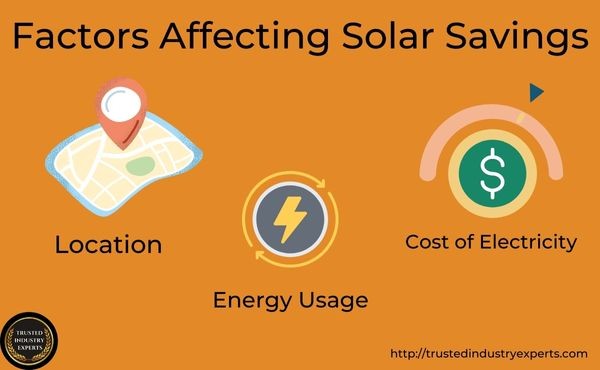How Much Can You Save with Residential Solar Installation in the US?

If you’re thinking of installing solar panels in your home, you’re probably wondering how much money you can save. The average savings depend on several factors, including your location, average electricity usage, and the cost of electricity in your area.
Solar panels can produce more energy than a home needs and this excess energy can be fed back into the grid. According to the National Renewable Energy Laboratory, an average residential solar installation in the US can lead to a 70-90% reduction in monthly electric bills. This means that with solar power, homeowners may see significant savings on their utility bills and power bill. With careful monitoring of energy consumption, these savings are likely to increase even further over time.
Factors Affecting Solar Savings

Location
The location of your property plays a crucial role in determining how much you can save with a solar installation. States with high electricity prices and abundant sunlight, such as California, can generate more savings than states with lower electricity prices and less sun, such as Maine.
When considering how much solar you can save with an installation in your home, it is important to consider the amount of solar panels that will be needed to produce the desired amount of energy. The number of solar panels that you need to purchase and install depends on how much electricity you use and how much sun your area gets. On average, a single solar panels produce about 1.3 kilowatts of electricity. Depending on the size of your home and energy needs, you may need solar panels worth to cover all of your usage.
Solar panels are worth the investment because they can provide long-term savings on your energy bills while also reducing your environmental footprint. In addition to purchasing the panels, you may need to set up additional components such as racking or inverters before installation. Solar companies can offer a variety of services including consulting, installation, maintenance, and more to help you get the most out of your solar setup.
Energy Usage
Another factor that affects your solar savings is your energy consumption. If you consume more electricity, you’ll likely see higher savings from solar. However, it’s important to note that solar panel systems have different sizes, and when it produce electricity will determine the size of the solar panel system you need.
When purchasing solar panels, it’s important to consider the size of the solar energy system you need. Solar companies can help you determine how much energy your home requires so that you can purchase the right number and size of solar panels. According to the Energy Information Administration, an residential utility customer household in the United States consumes about 10,908 kWh of electricity per year. Depending on your needs, you may need a larger or smaller solar energy system. In addition to helping reduce your electricity costs, a properly sized solar energy system will also allow you to generate excess clean energy which can be fed back into the grid. Solar companies offer a variety of services including consulting, installation, maintenance, and more to ensure that your solar panel system is installed and maintained correctly for maximum savings and efficiency.
Cost of Electricity
The cost of electricity in your area will also impact your solar savings. The higher the cost of electricity, the more you can save with solar.
The excess energy produced by solar panels can be used to power household appliances or even fed back into the grid. According to the National Renewable Energy Laboratory, an average residential solar installation in the US can lead to a 70-90% reduction in monthly electric bills and even greater savings on electricity and power bill. This means that with careful monitoring of energy consumption, homeowners may see significant savings on their electricity bills over time. Furthermore, with more energy being produced by residential solar installations, states may experience a decrease in overall electricity consumption and cost as more people opt for renewable sources of energy. As such, investing in solar panels could be beneficial for both individuals and society as a whole.
When it comes to determining how much solar panels are worth for residential installation, solar power savings can depend on a variety of factors. The amount of sunlight available in your area, the size of your home, and the cost of electricity in your region can all play a role in just how much you can save with solar.
Many solar panel systems come in different sizes and capacities, which will affect how many solar panels you need for your setup. Additionally, hiring professional solar installers can help ensure that you get the most out of your investment and maximize your savings. With their expertise, they’ll be able to ensure that the system is properly installed and optimized to get the most out of it. As such, calculating the worth of investing in residential solar panels requires an assessment of multiple variables.
Average Solar Savings in the US

According to recent studies, the average homeowner in the US can save about $600 per year with a 6-kilowatt solar panel system. The savings can vary significantly by state and region.
In addition to the savings mentioned above, homeowners may also be able to take advantage of federal tax credits for installing solar energy systems. The federal Solar Tax Credit allows homeowners to deduct 26% of the cost of their solar power system from their taxes. Depending on the size and complexity of the solar energy system, this could amount to thousands of dollars in savings.
Though the upfront costs of solar systems can be expensive, these savings, along with any excess solar energy generated, can offset those costs over time. Furthermore, many states offer additional incentives such as rebates or grants that can further reduce the cost of installing solar panels system. This means that although solar panels cost more initially, they can save you money in both the near and long-term.
How to Maximize Solar Savings
To maximize your solar savings, there are several things you can do:
Reduce Energy Usage
The less energy you consume, the more you can save with solar. You can reduce your energy usage by adopting energy-efficient habits, such as turning off lights and electronics when not in use, using energy-efficient appliances, and insulating your home.
Solar energy can provide energy savings for homeowners and businesses alike. Not only can you save money on your electricity bills, but you’ll also be helping to reduce overall electricity demand, which in turn helps to lower electricity rates for everyone. On average, a residential solar installation in the US could result in a 70-90% reduction in your monthly electric bill. This is due to the fact that most of the energy produced by solar panels is used to power household appliances and other necessities, reducing the amount of energy drawn and the greenhouse gas emissions from the grid and leading to lower electricity bills. Additionally, as more people adopt solar energy systems, it helps to reduce overall electricity demand, which keeps electricity prices low for everyone.
Choose the Right System Size
Choosing the right system size for your energy needs is essential to maximize your savings. A professional solar panel installer can help you determine the right size for your property.
Installing a residential solar energy system can be expensive due to installation costs and the cost of the panels. However, these costs can be offset by energy savings over time. The amount of savings will depend on your average electricity usage, the cost of electricity in your area, and the size of solar panel system you install.
On average, homeowners in the US can save about $600 per year with a 6-kilowatt solar panel system according to national averages. Additionally, homeowners may also be able to take advantage of federal tax credits for installing solar energy systems and other tax breaks that are available at both state and federal levels.
With careful monitoring of energy consumption, homeowners may see even greater savings on their electricity bills over time.
By producing electricity with solar panels, homeowners may be able to reduce their electricity bill by up to 70-90%, depending on their location and energy usage. The amount of electricity used by the average household in the US is 10,908 kWh per year.
To get the most out of a solar panel system, it’s important to purchase one that is properly sized for your energy needs. The National Renewable Energy Laboratory estimates that an average 6-kilowatt system can provide enough energy for the average home, leading to potential savings of up to $600 each year.
In addition to the cost savings from using solar energy, homeowners may also be able to take advantage of federal tax credits for installing solar systems. The national average electricity rate in the US is 12 cents per kilowatt hour and these rates vary from state to state.
With careful monitoring of energy consumption and taking advantage of available incentives, homeowners are likely to see significant cost savings over time with residential solar installation in the US.
Take Advantage of Incentives
There are many federal, state, and local incentives available to homeowners who install solar panels. These incentives can significantly reduce the cost of installation, making solar more affordable and increasing your savings.
When considering the cost of residential solar installation in the US, there are several factors to take into account. Installation costs can vary depending on the size of your system and any additional components you may need such as racking or inverters.
However, with careful monitoring of energy consumption, homeowners may be able to significantly reduce their energy costs over time. As an example, the average household in the US consumes about 10,908 kWh of electricity per year and a 6-kilowatt solar panel system can produce enough electricity to cover all of that usage.
In addition to reduced energy costs, homeowners may also be able to benefit from federal tax credits for installing solar systems. The national average electricity rate in the US is 12 cents per kilowatt hour and many states offer additional incentives such as rebates or grants which can further reduce installation costs.
This makes investing in solar panels more affordable and increases savings even further. Furthermore, taking advantage of available tax breaks can help offset further installation costs while providing long-term cost savings on energy bills.
In conclusion, the amount you can save with a residential solar installation in the US varies based on your location, energy usage, and the cost of electricity in your area. While the average savings are about $600 per year, you can maximize your savings by reducing your energy usage, choosing the right system size, and taking advantage of available incentives.
We hope this article helps you make an informed decision about solar panel installation and achieve energy savings on your energy bills.
Go solar with Trusted Industry Experts and Contact us here
#ResidentialSolar #SolarInstallation #SavingsWithSolar #EnergyEfficiency #SolarPanelSystems #IncentivesForSolar #ElectricitySavings #GoSolar



